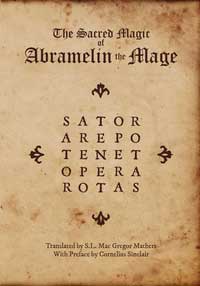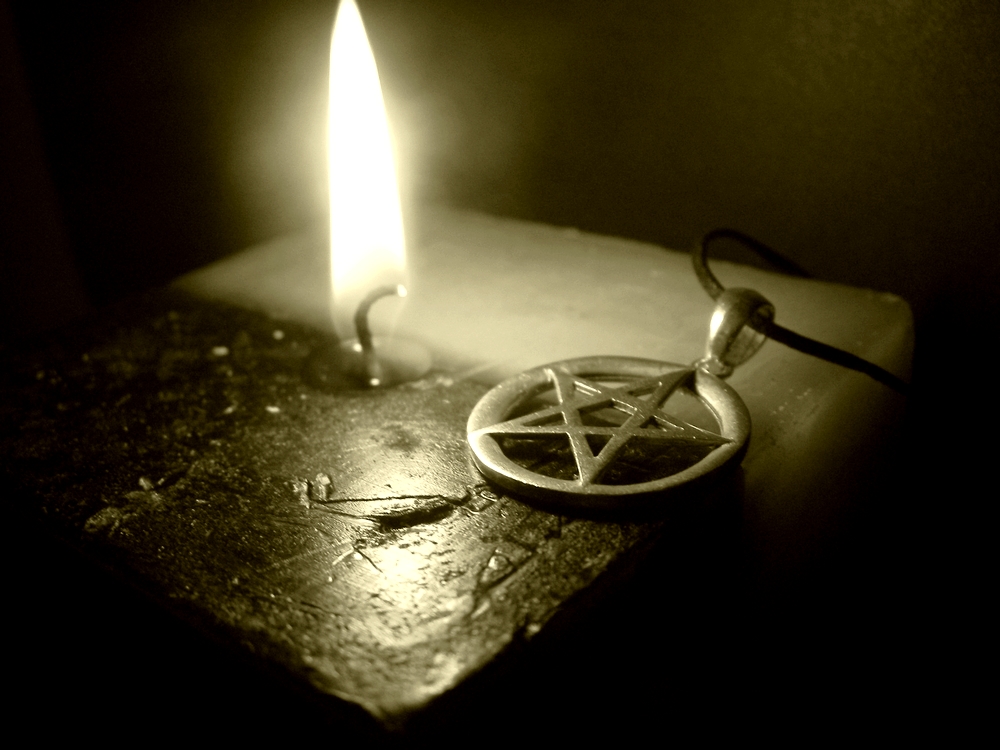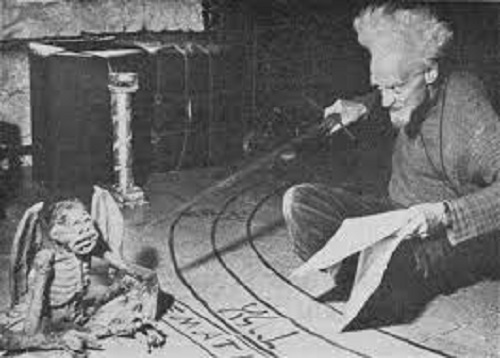Abraham of Würzburg, a cabalist and scholar of magic, describes a quest for the secret teachings which culminated in Egypt, where he encountered the magician Abramelin, who taught him his system in detail. The procedure involves many months of purification, followed by the invocation of good and evil spirits to accomplish some very worldly goals, including acquisition of treasure and love, travel through the air and under water, and raising armies out of thin air. It also tells of raising the dead, transforming ones appearance, becoming invisible, and starting storms.
The key to this is a set of remarkable magic squares, sigils consisting of mystical words which in most cases can be read in several directions. Of course, these diagrams are said to have no potency unless used in the appropriate ritual context by an initiate.
Mathers analyzed these words in an extensive set of notes and gives possible derivations from Hebrew, Greek and other languages.

This system of Abramelin the Mage is known from a unique fifteenth century manuscript preserved in the Bibliothèque de L’Arsenal in Paris. In it, Abraham of Würzburg, a cabalist and connoisseur of magics, describes a tour that he made of the then civilized world, visiting sorcerers, magicians, and cabalists, estimating their powers and virtues. This quest is in itself as fascinating as the similar tours of Gurdjieff.
The high point of Abraham’s travels was found in a small town on the banks of the Nile, where he encountered the great magician Abramelin, whose complete system Abraham thereupon sets out in detail. This amounts to a complete course in ceremonial magic (both white and black), which the student can pursue by himself.
Abramelin, whose system is based mostly on Hellenistic theurgy of the Iamblichan sort, but with Jewish increments from the Cabala, explains the qualifications needed to become a magician, purifications, and asceticisms to be practiced month by month, studies and activities permitted during this period, selection of place and time for working magic, equipment needed, prayers and formulas, evocation of good and evil spirits, commanding spirits to do one’s will, overcoming rebellious spirits, and similar material.
Specific instructions are offered to develop such powers as clairvoyance, divining metals and treasures, warding off evil magic, healing illness, levitation, transportation, rendering oneself invisible, creating illusions and glamour, reading minds, placing compulsions, working black magic, and a host of other abilities.
My recommendation to you, before you begin to entertain conducting rituals such as contained in this manuscript, is to understand what is expected from you in order to have success in such rituals. I suggest you review the link below, to give you a good idea.
https://www.sacred-texts.com/grim/abr/
The Goal
Seeking the conversation with the magician’s Holy Guardian Angel is the ultimate key to the work, and is called the “operation.” The preparation is elaborate, difficult, and long. All German translations have this period lasting eighteen months; however, Mathers reduced it to six.
The magician must lead a rigid lifestyle including daily praying before sunrise and a sunset, complete chastity must be observed, alcoholic beverages are to be refused, and all business is to be conducted in a scrupulously fair manner.
I have shared the importance of this step for many years, and in almost every video I have discussed on how to successfully perform ceremonial magic. The observations required and stated in this manual are absolute, and detrimental to the success and outcome of your operation.
At the completion of this preparation period, if successful, the magician’s Guardian Angel will appear revealing magickal secrets. Then the magician must evoke the twelve Kings and Dukes of Hell (Lucifer, Satan, Leviathan, Belial, etc.) and bind them. This way the magician therefore gains command over them thus dismissing their negative influence from his life. Then these demons are obliged to deliver familiar spirits ((four principal familiar spirits plus several more associated with a set of magickal word-square talismans described in Abramelin’s Book Four.)
The magician’s goals for which he employs the demons, particularly those found in grimoires, are to gain the ability to find buried treasure, to cast love charms, hexes, to magically fly, and have invisibility just to name a few. All magicians like magick are not alike; the magician’s intention directs his magick, if this magician’s is good then his magic is good, if evil then magick is evil. Magick is colorless, no black or white. The intention of the magician directs the purpose of his magick. This is why the Abramelin magic has produced treacherous results and given it a sinister reputation.
The Magic Square
Magic Squares play a prominent role in conducting the Abramelin operations as does a recipe for anointing oil (taken from Exodus 30) popularly used by ceremonial magicians and commonly known as “Abramelin Oil. ” Other tools include a holy Lamp, a Wand made of an almond branch, a recipe for “Abramelin incense” (taken also from Exodus 30), various Robes, a square or seven-sided silver plate or (bees) wax, and other tools.
Abramelin magick has been compared to Goetic Magick since both invoke demons but there is one major difference between the two: the chief aim of Abramelin magick is the conversation with the Holy Guardian Angel.
Magical squares composing the talismans in Abramelin magick are composed of letters, unlike magical squares usually composed of numbers, so to serve as teaching aids to students and operators. Since the focus of Abramelin magick is mystical each word or name within the square should relate to the magickal goal which the magician is striving to attain. The words are similar to the famous “SATOR, AREPO, TENET, APERA, ROTAS” word square.
In Abramelin certain words have specific significance. A square entitled “To walk under water as long as you want” contains the word MAIAM, the Hebrew and Arabic word for “water.” The square used for the recovering of treasurers of jewelry begins with the word TIPHAREH, a variant of tiferet, which can mean “golden ring” and is also the name of the sphere for Beauty,” also a planetary attribute of the Sun, on the Kabbalistic Tree of_Life.
Important changes made in this version from the original manuscript
Since the time of Mathers’ translation, The Book of the Sacred Magic of Abramelin the Mage has remained popular among English-speaking ceremonial magicians and occultists interested in Hermetic Qabalah, Christian Kabbalah and grimoires. A paperback reprint during the renewed rise of interest in hermeticism during the 1970s placed the book before a new generation of readers, and one offshoot of this was that a number of people, both within and without the Thelemic and Golden Dawn communities, claimed to have either undertaken the Abramelin operation in toto or to have successfully experimented with the magic squares and Abramelin oil formula found in the text.
There are several important differences between the original manuscripts and Mathers’ edition.
First, one of the four books was missing entirely from the French manuscript with which he worked.
Second, Mathers gave the duration of the operation as six months, whereas all other sources specify eighteen months.
Third, possibly due to a mistranslation, Mathers changed one of the ingredients within the recipe for Abramelin oil, specifying galangal instead of the original herb calamus. The oil in the German manuscript sources also contains cassia and is nearly identical to the biblical recipe for Holy anointing oil. The differences between the recipes cause several notable changes in the oil’s characteristics, including edibility, fragrance, dermal sensation, and spiritual symbolism.
Fourth, there are 242-word squares in Mathers’ translation, while the original German has 251. Most of the squares in Mathers are not completely filled in, and those that are differ from the German sources. A German translation, credited to Abraham of Worms and edited by Georg Dehn, was published in 2001 by Edition Araki. In the Dehn version, the fourth book is included and Mathers’ galangal substitution is reverted to calamus (though not in the English translation). All 251 of the word squares are completely filled in.
Influence on modern ceremonial magic
This book has had a huge influence on modern ceremonial magic, and has been cited as a primary influence on Aleister Crowley.
The 1898 translation of the Sacred Magic of Abramelin the Mage, having a reputation for being a sinister grimoires, by Samuel L. M. Mather had a great influence on the Hermetic Order of the Golden Dawn. In 1904 as a young member of the Golden Dawn Aleister Crowley prepared to carry out the operation. Crowley had roomed with Allan Bennett a Buddhist in poor health suffering terribly from asthma. Drugs were the one thing that relieved his suffering. Crowley learned much from Bennett’s tutoring and was impressed by his intelligence. It was with this knowledge that Crowley prepared to perform the Abramelin operation.
Crowley commenced performing the Abramelin, a six-month black magic ritual that nobody had dared undertake in centuries. While the aim of the ritual is to invoke the magician’s Holy Guardian Angel, to do so he must also evoke the twelve Kings and Dukes of Hell – including Lucifer, Satan, Leviathan and Belial – and bind them, thereby gaining command of them in his own mental universe. The ceremony has an introduction which states that nobody should perform it.
Before interrupting the Operation Crowley wrote that the “demons connected with the Abramelin do not wait to be evoked; the come unsought.” During his attempts at the Operation there were strange occurrences. Once, for example, Crowley and another Dawn member observed semi-materialized beings march around the room in almost endless procession. They speculated they were using a powerful magickal practice.
We do not guarantee that Abramelin’s techniques work, nor that the results are desirable, but we offer this as a genuine medieval course in magic, one of the most important books in the history of occultism. It is of paramount importance to both the historian and the practitioner.
Sources:
Belanger, Michelle. The Dictionary of Demons: Names of the Damned
The Book of Abramelin, From Wikipedia, the free encyclopedia





